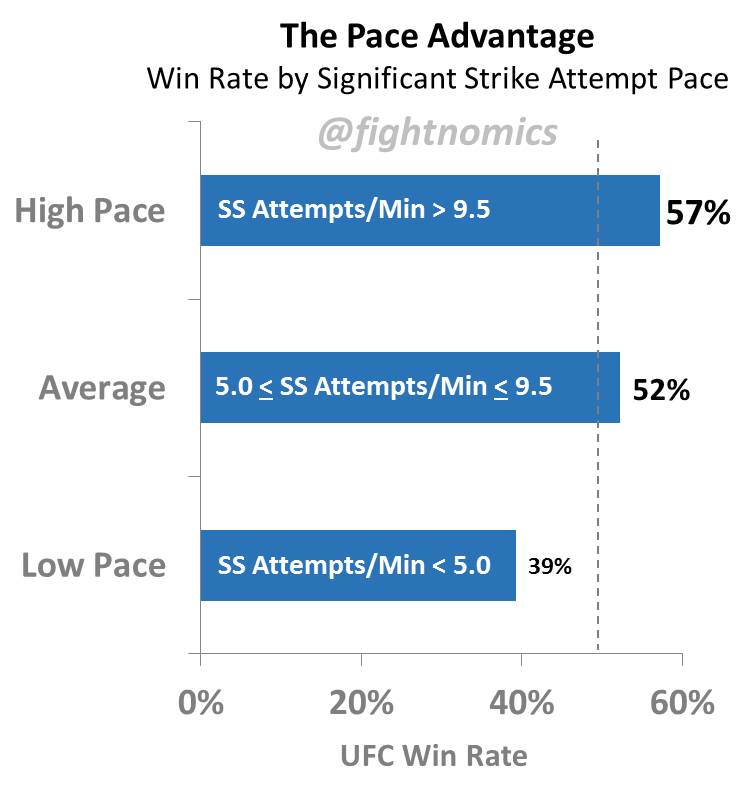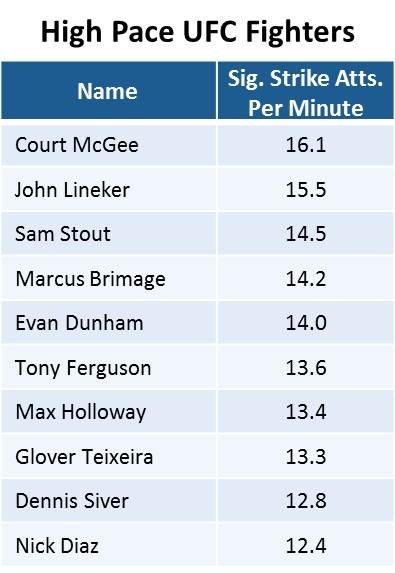The importance of pace should be obvious to fighters, fans, and judges alike. Pressing the action means launching more weapons, each one offering a small probability of being the one that counts. Even in fights that go the distance, a high pace of output means a fighter doing all they can to control the action, impose their will, and win the round. But what does it mean for the MMA gambler? Can knowing a fighter’s pace help inform betting decisions? FightMetric has a public profile for every UFC fighter that includes their Significant Strikes Landed per Minute (SLpM) metric, and their Significant Striking Accuracy (or just Str. Acc.). Dividing SLpM by the Accuracy gives the fighter’s Significant Strike Attempts per Minute, or what I will call “pace.” The more active a fighter is, the better they should do. While this statistic isn’t readily available on the Tale of the Tape, the information is accessible to all via the FightMetric website. The question is, is it useful? To test the fundamental importance of pace in MMA, we can classify fighters by their average pace of output and then examine wins and losses to see if being in a low or high pace group has any effect on outcomes. For all UFC fights since 2008, fighters were grouped by their average pace, measured in Significant Strike attempts per minute, where the average was around 7.2. I then created a threshold for “Low” and “High” pace fighters, and ran fight outcome analysis using these groups. The baseline win rate for this period of time was slightly less than 50% (remember there’s always a few draws or no contests). I did that math so you don’t have to, and these results should be no surprise.
The numbers show what we would expect: low-pace fighters lose more often than not, while being a high-pace fighter carries an advantage. Separating fights that ended by stoppage versus decision did not change the numbers substantially, which suggests that a high pace is equally good for fighters who finish as it is for those who win on the cards. Keep in mind, all other factors (reach, stance, age, etc.) in this analysis were ignored. This was just analysis of a single metric to see if it has any predictive value. There’s also a more subtle takeaway that while high pace is good, more importantly low pace is terrible. The degrees of those differences are not equal. The difference between the groups is more pronounced for the low-pace group of fighters in that they see nearly an 11% drop from the baseline win rate compared to a 7% boost enjoyed by high-pace fighters. “Average” fighters that didn’t meet either differentiating threshold still fared a little better than the baseline for win rates, meaning you don’t have to work at a high pace to compete and survive in the UFC, as long you don’t lag behind. The “Pace Advantage” may not have ever been described before in MMA, but this is the first of many “advantages” that analytics are allowing us to test. What’s so simple and elegant about this metric is that it does not reflect skill or strength, but merely fighters that pull the trigger and push the pace. In terms of Significant Strike accuracy, there was actually an inverse correlation with pace, resulting in low pace fighters having the highest accuracy, high pace fighters having the lowest accuracy, and average fighters falling in between on both metrics. So Significant Strike accuracy doesn’t seem to be a strong predictor of outcomes. We’re also seeing the first hint that the rate of Significant Strikes landed may not be the key differentiator either compared to the rate of attempts. Apparently it’s not always the damage done when it comes to winning fights, it’s the thought that counts.
Next time you’re researching a tough match-up, or trying to find an edge on a close line, consider checking the pace of the two fighters. A big differential could mean that one fighter will end up controlling the cage and forcing the action. A low pace fighter who lacks finishing weapons will be at a huge disadvantage against anyone who has pace on their side. Math may not be required, just knowing the style and tendency of fighters who can pull the trigger versus those who hang back will be enough to inform the match-up a little better than just by relying on the Tale of the Tape.

